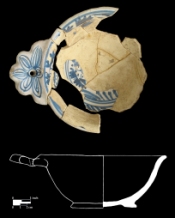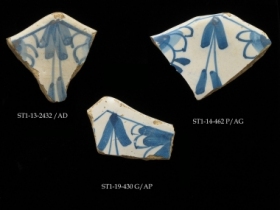Ceramic Porringer

Conservator’s Notes
Tin-glazed earthenware that was discovered and excavated at HSMC was particularly fragile when it was discovered. A large fragment of delftware was unearthed and several large sherds were found in association with one another in the ground. The field staff was aware of the fragility of delftware and the problems they suffer in relation to their porous structure and soft glaze. As the ground was damp, it was decided to lift the large ceramic sherds as one group together in the soil matrix in which it was found.
The ceramic and soil were lifted carefully in the field, supported using foam and containers and brought into the conservation laboratory to undergo examination and cleaning. Because the surrounding soil was moist, it was necessary to keep the ceramic and soil moist until further work could be completed. This was accomplished by inserting moist toweling inside the bucket with the artifact and soil, and sealing the entire thing in polyethylene plastic. A careful watch was kept to ensure that the artifact and soil did not dry out, yet the growth of mold and other fungi was not imminent.
A mini-excavation was performed in the conservation laboratory to slowly remove the soil from around the ceramics. Small tools, including wooden picks and water were used to remove as much soil as possible without scratching or damaging the ceramic. At no time were metal tools used this close to the glaze of the ceramic. As more and more soil was removed, it became evident that salt damage was causing flaking glaze and some loss to the glazed areas. In order to keep the glaze intact, a stable resin (consolidant) was applied to keep the glaze from moving and getting lost. As time progressed, more and more soil was removed and more and more of the ceramic was revealed.
Some of the larger pieces of the ceramic were not attached nor could they be mended. Missing fragments have not been identified as of yet, in order to finish piecing the object together. Each fragment was cleaned of dirt, consolidated and stabilized so they could be further handled and archived with the archaeological collection.
Curator’s Notes

Tin-glazed earthenware was one of the most lavishly decorated table wares of the colonial period. Tin glaze is essentially a lead glaze with tin added that results in a thick white opaque layer of very glassy material. Tin glazes are applied to pottery that has already been fired to an earthenware temperature and then it returns to the kiln for a second firing at a lower temperature which fixes the glaze. Tin glazed earthenwares are variously known as tin enameled, delft, delftware, majolica, faience, or maiolica. For simplicity sake we will refer to it as tin glazed earthenware. In the colonial period, with the exception of Hispanic production, tin glazes are a European manufactory.
The specimen described in the conservation treatment above is in the form of a porringer. Porringers were essentially bowls with handles in the form of a flat projection from the rim and were designed for consuming semi-liquid foods such as porridge.


